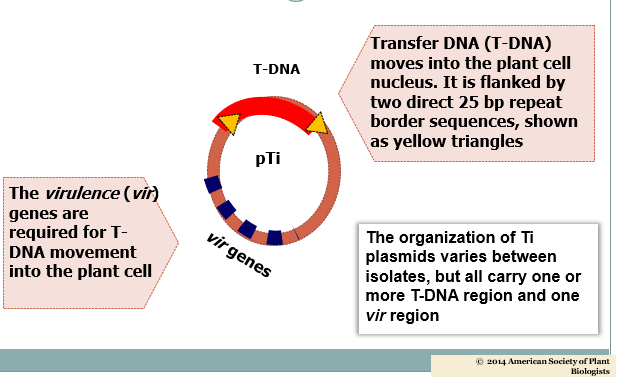Introduction:
Transgenic plants are those plants in which foreign genes have been introduced and stably integrated into the host DNA. The plants that have undergone transformation produce the proper gene product as a result.
The different methods of introducing foreign DNA into the plant genome have been grouped under two broad categories i.e., vector-mediated gene transfer and direct gene transfer.
Agrobacterium-mediated gene transfer is an example of vector mediated gene transfer.
Agrobacterium tumefaciens is a rod shape gram negative soil plant pathogen that induces tumours on about 60% of dicotyledonous angiosperms and gymnosperms.
It naturally infects plant wound sites and causes diseases like crown gall and hair roots via delivery of transferred (T)-DNA from bacterial cells into host plant cells.
This tumour-inducing property also makes it a valuable tool for introducing genes into plants for research and agricultural purposes.
Organization of Ti plasmid:
Within the Agrobacterium cells, there are circular DNA molecules called Ti plasmids, which have an approximate size of 200 kb each. The length of the T-DNA (transferred DNA), which varies depending on the bacterial strain from which the Ti plasmids are derived, is in the range of 12 to 24 kb. While octopine strains of Ti plasmid have two T-DNA portions with lengths of 14 kb and 7 kb, respectively, and are referred to as TL and TR, nopaline strains have one T-DNA with a length of 20 kb.
The Ti plasmid has three important regions.
T-DNA region
This region is surrounded by the left and right borders and contains the genes for the production of auxin (aux), cytokinin (cyt), and opine (ocs). The plant cells additionally receive a transfer of a set of 25 kb sequences that are located on either side (left and right) of T-DNA.
Virulence region or vir region
The region is known as the vir or virulence region, and the genes that transfer T-DNA into the host plant are found there. The Vir region genes for the proteins that transfer T-DNA. There are at least nine vir-gene operons known that comprise vir A, vir G, vir B1, vir C1, vir D1, vir D2, vir D4, vir E1 and E2.
Opine catabolism region
Proteins involved in the absorption and metabolism of opines are encoded in this area.
Opines are low molecular weight compounds found in plant crown gall tumours or hairy root tumours produced by pathogenic bacteria that are used as an important energy, carbon and nitrogen source by the bacterium.

Fig: Structure and function analysis of the Ti plasmid
Steps:
- Attachment of A. tumefaciens to the plant cells.
- Sensing plant signals by A. tumefaciens and regulation of virulence genes in bacteria following transduction of the sensed signals.
- Generation and transport of T-DNA and virulence proteins from the bacterial cells into plant cells.
- Nuclear import of T-DNA and effector proteins in the plant cells.
- T-DNA integration and expression in the plant genome.

Fig: Major steps of the Agrobacterium tumefaciens-mediated plant transformation process.
Procedure or Protocol of Gene Transfer:
The pathogenic soil bacteria Agrobacterium tumefaciens, which causes crown gall disease, can insert a portion of its plasmid DNA (referred to as transfer DNA or T-DNA) into the nuclear genome of infected plant cells.

Fig: Agrobacterium-Mediated Gene Transfer (Transformation) in Plants
Factors influencing Agrobacterium-mediated transformation:
T-DNA transfer and integration into the plant genome are governed by a variety of Agrobacterium and plant tissue-specific factors, including plant genotype, explant type, plasmid vector, bacterial strain, culture medium composition, tissue damage, and suppression or elimination of Agrobacterium infection after co-cultivation.
Applications:
- Massive efforts for crop genetic improvement have been undertaken all over the world with the invention of efficient genetic transformation techniques employing Agrobacterium.
- Gene introduction by Agrobacterium is now the most frequent method of transformation and has the potential to change the characteristics.
- This approach is very simple and relatively inexpensive, with a high transformation efficiency.
- Transgenic crops obtained have a higher fertility percentage.
- It has been used to genetically modify plants in order to produce various useful proteins such as recombinant antibodies (plantibodies) and edible vaccinations (plantigens)
References:
- Hwang, H.H., Yu, M. and Lai, E.M., 2017. Agrobacterium-mediated plant transformation: biology and applications. The Arabidopsis Book, 15.
- Schulze, ED., Beck, E., Buchmann, N., Clemens, S., Müller-Hohenstein, K., Scherer-Lorenzen, M. (2019). Biotic Stress. In: Plant Ecology. Springer, Berlin, Heidelberg. https://doi.org/10.1007/978-3-662-56233-8_8
- Gelvin SB. Agrobacterium-mediated plant transformation: the biology behind the “gene-jockeying” tool. Microbiol Mol Biol Rev. 2003 Mar;67(1):16-37, table of contents. doi: 10.1128/MMBR.67.1.16-37.2003. PMID: 12626681; PMCID: PMC150518.
- Abuodeh, R. O., M. J. Orbach, M. A. Mandel, A. Das, and J. N. Galgiani. 2000. Genetic transformation of Coccidioides immitis facilitated by Agrobacterium tumefaciens. J. Infect. Dis. 181:2106-2110.
- De La Riva, G.A., González-Cabrera, J., Vázquez-Padrón, R. and Ayra-Pardo, C., 1998. Agrobacterium tumefaciens: a natural tool for plant transformation. Electronic journal of Biotechnology, 1(3), pp.24-25.
- Narusaka, Y. et al., 2012, ‘Methods to Transfer Foreign Genes to Plants’, in Y. &. Çiftçi (ed.), Transgenic Plants – Advances and Limitations, IntechOpen, London. 10.5772/32773.
